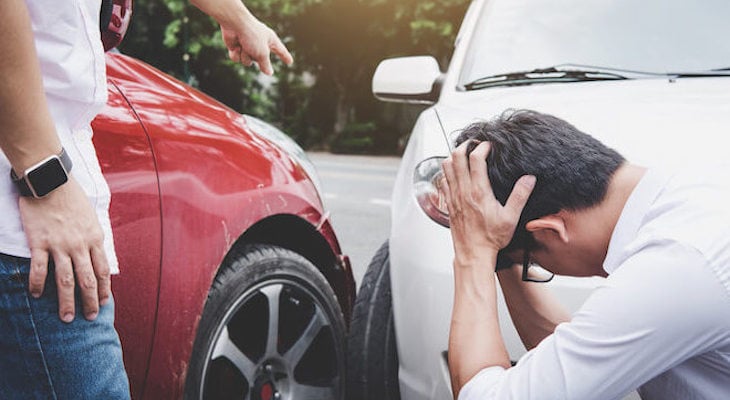What Is Uninsured Motorist Coverage and Is It Worth It?
At Compare.com, it’s our mission to find simple ways to help our customers save money on the things they need. While we partner with some of the companies and brands we talk about in our articles, all of our content is written and reviewed by our independent editorial team and never influenced by our partnerships. Learn about how we make money, review our editorial standards, and reference our data methodology to learn more about why you can trust Compare.com.
According to the Insurance Information Institute (III), as many as 12.6% of drivers in the U.S. don’t have car insurance. That number varies widely from state to state and is as high as 16.6% in California and as low as 6.1% in New Hampshire.
In addition, with increasing insurance costs, drivers are less willing to pay more than what’s necessary for car insurance. The growing number of cut-rate auto insurance policies that offer a bare minimum of coverage underscores the real risk for buyers as well as other drivers.
Compare Car Insurance Rates
With so many uninsured and underinsured drivers on the road, you should consider including uninsured motorist coverage on your car insurance policy.
What Is Uninsured Motorist Coverage?
Uninsured motorist insurance covers the cost of damages when the driver who caused the accident has no auto insurance. This coverage also provides protection during a hit-and-run accident when a driver flees the scene of a car accident.
You may need this type of coverage because your liability or collision insurance policy may not pay out if the other driver is at fault. Ordinarily, you would file a claim with the at-fault driver’s insurance company for any car repairs or medical bills.
But if the other driver doesn’t have insurance coverage, you could be stuck paying for repairs and medical expenses out of pocket. With uninsured motorist coverage, your insurance company steps in to cover those costs.
Uninsured vs. Underinsured Motorist Coverage
Uninsured motorist coverage (UM) and underinsured motorist coverage (UIM) are very similar. But it’s worth noting that they cover two different types of incidents, and you may have to purchase them as separate add-ons to your policy:
- UM coverage protects you in situations where the other driver doesn’t have any auto insurance coverage at all (or is a hit-and-run driver)
- UIM coverage protects you if the other driver doesn’t have enough insurance coverage and isn’t able to cover all of the cost of the accident
Just as with collision coverage and liability coverage, your insurance policy may have different payout amounts for property damage claims vs. bodily injury claims:
- Uninsured motorist bodily injury coverage (UMBI) covers costs related to bodily injury, such as medical payments and lost wages
- Uninsured motorist property damage coverage (UMPD) covers damage to your vehicle or property, such as car repairs
When adding these types of coverage to your policy, you must assign maximum payout values for bodily injury and property damage. UMBI coverage establishes a “per person” and a “per accident” limit, while UMPD sets a “per accident” limit. These values usually match your liability insurance policy limits, which may vary from company to company.
How the Coverage Works
Let’s say someone runs a red light and hits your car. Since they were clearly at fault in the accident, you’d expect their insurance company to take financial responsibility for it. The total cost of your claim against their car insurance company is $250,000 to cover repairs, hospital bills, lost wages, pain and suffering, and other related expenses.
However, the person who hit you has a car insurance policy that will pay out a maximum of $100,000 per person per accident. Their insurance will pay $100,000, but not the remaining $150,000. So, what happens next?
If you have an underinsured motorist insurance clause in your car insurance policy, your car insurance company will pay out. These levels are typically the same coverage levels as your liability limits, but this can vary, so consult your car insurance policy or discuss this with your insurance agent.
Let’s say you have coverage limits of $100,000/$300,000 for bodily injury and liability claims. As previously mentioned, your underinsured motorist insurance typically pays out with matching coverage levels.
The underinsured motorist insurance clause of your car insurance policy will pay an additional $100,000 toward the $150,000 worth of medical costs still outstanding per your liability coverage limits.
What to Do if Your Insurance Doesn’t Cover All Costs
Wait! That leaves you with $50,000 worth of bills. What are your options to get those bills paid? In some cases, your insurance policy, even combined with the insurance of an underinsured driver, may not be enough.
It’s rare, but it can happen if you drive an expensive vehicle or have unusually high hospital bills. At this point, your primary option is litigation against the at-fault driver to sue them for the remaining cost of your expenses.
If you’re the at-fault driver, paying out of pocket is your only option. We recommend speaking to an attorney specializing in auto insurance law to discuss your options. It’s also a good idea to hire an attorney any time you’re involved in a motor vehicle accident that results in you or another party being injured.
Do You Need Uninsured Motorist Coverage?
Do you need uninsured motorist coverage before you take your vehicle out on the road? That depends on where you live. Each state has its own insurance requirements that define the type of insurance coverage and the amount of coverage you need.
According to III, 19 states require drivers to have some type of UM or UIM coverage. In some states, only uninsured motorist bodily injury coverage is mandated, and uninsured motorist property damage coverage is optional.
Still, even if your state doesn’t require it, having uninsured motorist coverage is usually a good idea. It typically won’t add much to your insurance premiums but will give you one less thing to worry about if you get into an accident with an uninsured driver.
Plus, uninsured motorist coverage can protect you in other situations, such as a hit-and-run accident or if the other driver’s insurer goes out of business.
It’s especially important if you don’t have health insurance or have a high deductible and would face high out-of-pocket costs if you get injured in an accident.
Is Uninsured Motorist Coverage Right for You?
Like it or not, not every driver has car insurance, and some states have higher rates of uninsured drivers than others. If you get into an auto accident with an uninsured driver and they’re at fault, your collision and liability insurance policy won’t cover you — you’ll be expected to make a claim with the other driver’s car insurance company.
Uninsured and underinsured motorist coverage gives you additional protection in these situations. If the other driver doesn’t have insurance or doesn’t have enough insurance, your insurance company will cover the cost of damages.
If you want to compare rates on policies that have underinsured and uninsured motorist coverage, start our quote process below. We will match you with multiple companies to help you find the best deal. Compare your current rates and choose the insurer that best suits you. It’s that simple.
Find the Best Car Insurance for You
Compare Car Insurance Quotes
About Compare.com
Compare.com’s #1 goal is to save you money. We publish resources that are based on hard-hitting data and years of industry experience to help you make more informed decisions with your wallet.
- All of Compare.com’s content is written and reviewed for accuracy by a team of experienced writers and editors who are experts on the topics they cover.
- None of Compare.com’s content is ever influenced by the companies and brands we partner with.
- Compare.com’s editorial team operates independently of any of the company’s partnership or business development interests. We publish unbiased information strictly for the benefit of our readers.
- All of the content you see on Compare.com is based on comprehensive analysis and all data is gathered and vetted from trustworthy sources.
Learn more about us, our team, and what makes us tick.







